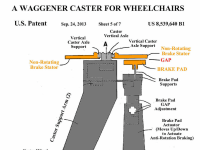For an unassisted person using a manual wheelchair, small barriers can impede safe passage, cause stranding, and contribute to user accidents. Wheelramps provide easier and safer passage over these barriers. Wheelchair-related hospital admissions will be reduced and users can enjoy improved independence.
A usual caster consists of a wheel mounted on a horizontal axis, disposed rearward from a vertical axis shaft located on the bottom of a vehicle, such as a wheelchair, shopping cart, or industrial cartage. A wheelchair caster wheel radius typically ranges from two to four inches to save space. When a large percentage of the weight is borne by the front caster wheels, the small caster radius makes overcoming even small obstacles difficult
Figure 1 illustrates my Wheelramps, a new caster arrangement first described in US Patent 8,539,640 B1. Wheelramps improve safety and reduce the force needed to overcome obstacles by introducing a secondary wheel/pulley and belt arrangement, thereby forming a built-in ramp. However, if the ramp encounters an obstacle forward of the vertical caster axis, the Wheelramp may try to turn in an unwanted direction. This possibility is avoided by allowing the ramp to slightly elevate, thus activating a vertical axis anti-rotation brake, and then to release the brake when the ramp is no longer elevated. Forward motion is not otherwise impeded, so normal travel is unhindered.
Figure 2 illustrates prototype Wheelramps mounted on a manual wheelchair. The caster wheels were fitted with grooves machined for commercial v-belts incorporating Kevlar cords, and belt tensioning was established by construction alone. Initial results were encouraging, as ¾ inch high barriers were easily overcome, but it became apparent that belt tension was inadequate to establish really excellent ramp characteristics - the belt was over-deflected upwardly when heavily loaded, thus reducing the desired improvement.
Figure 3 illustrates several newer modifications. (1) The wheel/pulley grooves are modified to accommodate an inverted v-belt. V-belt inversion places the tensioning cords closer to the bottom of the grooves, reducing friction. (2) The auxiliary pulley is now supported by a clevis and tensioning bolt/nut arrangement. (3) Bellville washers have been added under the tensioning nut to insure consistently high belt tension.
Not Illustrated: (4) The horizontal caster wheel axis and the caster support axis arms are now separated and, (5) A simplified strong upper support for the vertical brake actuator has been devised. This Wheelramp is easily manufactured, tensioned, and more easily installed or serviced for a wider number of wheelchairs.
Other applications of the technology include carts, gurneys, walkers, and various industrial applications. These additional implementations are expected to improve cart utility where surfaces are not perfectly flat. Overcoming small elevation changes of 1 to 1.5 inches or so caused by door thresholds, frost heaves, uneven ground settling, or other imperfections will improve user safety, satisfaction, have less impact on cartage transport, and possibly reduce facility maintenance costs. The inventor is unaware of anything like this on the market!
HAW Jun 17
Like this entry?
-
About the Entrant
- Name:Herbert Waggener
- Type of entry:individual
- Software used for this entry:none
- Patent status:patented








